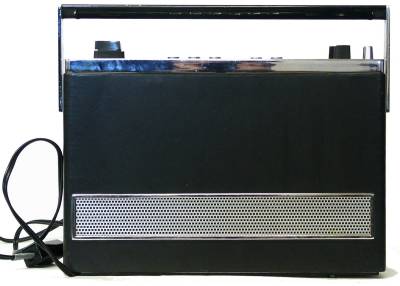Inhaltsverzeichnis
Nordmende Globetrotter
Variant 4.601, green, 1964/65
Manufactured by Nordmende, Bremen; chassis number 864.601.00.
As the first of a whole series of portable travel radios, as forefathers of modern „world band receivers“, Nordmende launched the „Globetrotter“ in 1964 and entered the scene as a direct competitor of Grundig with its world band receivers of the „Satellit“ series.
The first Globetrotter series can be recognized by a green coloured labels of the band spread dial, the Globetrotter lettering below the speaker grille on the front is in cursive: in 1964, the catalogue price was 695 DM.
Technical data
- Frequency range: FM, LW, MW, MB, 11 x SW (80 / 61 / 59 / 49 / 41 / 31 / 25 / 19 / 16 / 13 / 11 m)
- Frequency display: Analogue dial, band spread with linear logging dial (0 - 100)
- Frequency memory: none
Power supply
- Mains operation: 6 resp. 12 V = from the car battery
Dimensions
- 310 x 209 x 105 mm, weight 3.8 kg
Accessories
Operation
The first Nordmende Globetrotter is a single conversion radio with 11 spread shortwave bands in addition to the longwave, mediumwave and FM broadcast bands. The dials are only analogue, which was standard according to the time when the set was designed. But the linear logging dial numbered 0 - 100 is not calibrated, so tuning in a known frequency is a guessing game. However, if the dial pointer position on the log scale of a frequency once found is recorded in the notebook, it is easier to find the station again the next time you try.
The Globetrotter is a portable set built into a wooden case with leatherette cover, the front panel dimensions are 31 x 10.5 cm, the set is 21 cm high and has a weight of 3.8 kg.
The controls and dials are located on the top face of the receiver, the large loudspeaker is on the front, but the Globetrotter can also be operated in a lying position, the carrying handle serves as a stand to keep the set in a tilted position.
This earliest variant of the „Globetrotter“ has round band pushbuttons and green coloured labels on the band spread dial; on the successor model, which appeared in 1965, the markings are orange.
On the front panel, at the left, you find the telescopic antenna, the rotary controls for treble, bass and volume control, the latter combined with the power switch. When the treble control knob is depressed, the S-meter immediately next to it indicates the battery level, and when the bass control knob below it is depressed, the dial illumination is activated.
The round pushbuttons above the frequency dial select the band ranges; as a special feature, the S button activates the marine radio band between 200 - 80 m, the BANDS button activates the spread shortwave bands and the leftmost button activates the AFC in the FM range and selects between the narrow and the wide IF filter on the shortwave ranges.
Of the two large rotary knobs, the upper one acts as selector for the spread shortwave bands, and the outer ring operates the tuning control. The tuning knob below tunes the LW/MW/S ranges, the outer ring the VHF broadcast band.
 At the bottom, the cover is fixed by two screws and it has to be removed completely to change the batteries, there is a compartment for 5 UM-1 batteries, an external 7.5 V power supply can be connected. Behind a cover on the bottom face of the set, there are some plug-in contacts, the Globetrotter could be plugged into a car adaptor and thus could be operated with its 6 or 12 V on-board voltage, a direct mains connector is missing.
At the bottom, the cover is fixed by two screws and it has to be removed completely to change the batteries, there is a compartment for 5 UM-1 batteries, an external 7.5 V power supply can be connected. Behind a cover on the bottom face of the set, there are some plug-in contacts, the Globetrotter could be plugged into a car adaptor and thus could be operated with its 6 or 12 V on-board voltage, a direct mains connector is missing.
Operating the radio does not pose any challenges: switch on using the volume control knob, select the spread SW ranges with the BANDS pushbutton, turn the upper rotary knob until the 49 m band is displayed in the tiny viewing window, look for the interval signal of the Austrian Radio around 6155 and you are done. The set does not tell you, on which position to find the Austrian Radio on the 0 - 100 linear dial. Once the station has been identified, however, the position of the frequency can be read off the logging dial and can be written down in a notebook, so to make it easier to find the station another time.
The Globetrotter - compared to other sets from its time of origin - is a quite good performer. Some drawbacks are the complete lack of calibrated dial markings that would give you orientation within a shortwave band, the fact that the receiver has no continuous coverage of the shortwave range so that out-of-band stations cannot be tuned, and the lack of SSB capability.
In summary, the Nordmende Globetrotter was a serious travel receiver in the mid-sixties, today it is more of a collector's item. Due to the good audio, listening to the strong international foreign broadcasters can still be a pleasure. If you do not remember the assignment of the stations within a shortwave band, you will have difficulties finding or identifying stations, so you should better look for a set with a digital frequency display.
Technical principle
Single conversion heterodyne with spread shortwave bands, turret tuner.
Components
The set is equipped with semiconductors.




